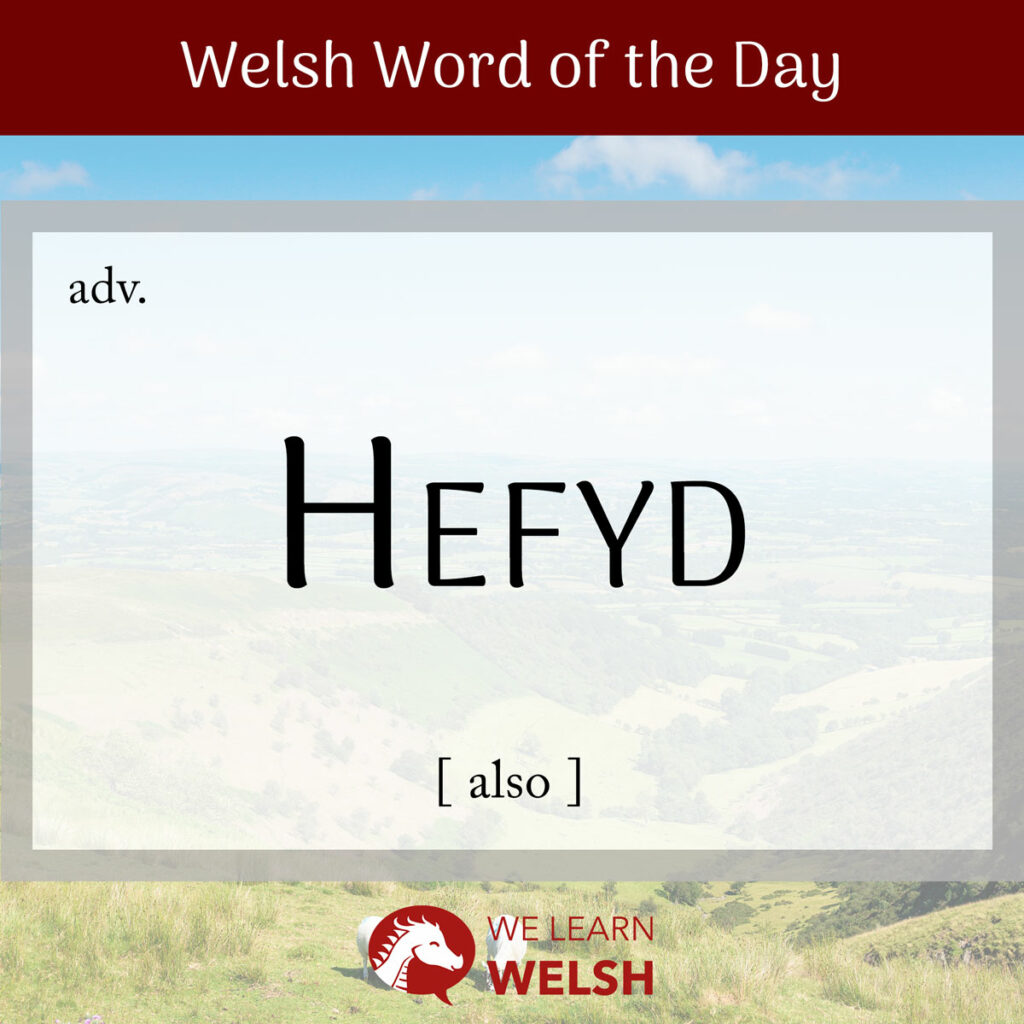When you’re learning a new iaith (language), it’s tempting to focus on memorising lots of nouns and adjectives. They’re easier to relate to everyday life, and much less likely to present confusing grammatical challenges.
But adverbs, prepositions and conjunctions are just as important. They’re key if you ever want to be able to use Welsh in more advanced contexts, like reading llenyddiaeth (literature) or discussing gwleidyddiaeth (politics). One short Welsh adverb that’s just as useful as it is easy to learn is hefyd, which means also.
hefyd
also
Hefyd probably comes from the same root as the word hafal (equal); it may even be directly descended from it. Their ancestor is *samalis, a proto-Celtic root word which is an etymological cousin of the English similar, coming originally from Latin.
Just as we sometimes say also where more formally moreover might be inserted, hefyd or a hefyd can be used as a translation of moreover. There are some synonyms for it if you want to switch things up in a traethawd (essay) or araith (speech), such as ymhellach (furthermore), ar ben hynny (on top of that), ar hynny (at that), and yn ogystal (equally).

In English, we often use the word too as a synonym of also, especially at the end of sentences. It sounds a bit more casual and natural to say I did that too than I did that also, although the latter isn’t technically incorrect. In Welsh, all these variations just become hefyd, and hefyd can be used at the beginning, at the end, or in the middle of a sentence.
And too as in too much is a different word in Welsh, which is rhy. Another common option is to add the prefix gor– to the start of an adjective. So for example, you could say gorlawn to mean too full.
Here are some simple expressions using hefyd. Why not pick one and try slotting it into your next Welsh conversation?
- ond hefyd = but also
- felly hefyd = so also
- fi hefyd / fi ‘fyd = me too
- hyn hefyd = this too
- byth a hefyd = perpetually
- mae hefyd yn = it is also
- gweler hefyd / gw. hefyd = see also
- a hefyd = and also
Now, there’s a lot of confusion in Welsh – even amongst native speakers – about when to use a and when to use ac. These words both mean and. In general, ac is used before words starting with vowels, and a is used before words starting with consonants.
Roedd e’n hynod o flasus, ac yn rhad iawn hefyd.
It was extremely tasty, and also very cheap.
But there are a few letters in the Welsh alphabet which sit in-between being a vowel and a consonant, which are i, w, and h.
Generally the first two are considered vowels and h is considered a consonant. But i and w function as consonants in many Welsh words. And because h is said without ever closing the mouth, it feels a bit like a vowel physically.
Hefyd, there’s a bit of havoc caused by another rule. In Welsh, the definite article the can appear as either y, yr or ‘r. The last appears when the word before it ends in a vowel. In terms of choosing between y and yr, the former is standard, but yr is used when the word afterwards starts with a vowel sound or with h. H being grouped in with vowels here makes its status quite confusing!
Because of this, although technically the correct choice for hefyd is a hefyd, many people go for ac hefyd. Honestly, this is a mistake made by learners, second-language speakers, and first-language speakers alike. I wouldn’t be surprised if some dialects even considered it standard.
It’s worth knowing, though, that a hefyd is generally considered the correct choice. While it’s not a big deal to use ac hefyd in conversation, it would count as a grammatical error if you ever wanted to take a Welsh language exam.
The negative version of hefyd is chwaith. This is a bit like either or neither in English – and the same word chwaith is used for both, we don’t separate them. So, consider the two phrases below.
Dw i eisiau dod hefyd!
I want to come too!
Dw i ddim eisiau dod chwaith!
I don’t want to come either!
They’re pretty direct equivalents – hefyd to also and chwaith to either / neither. In old-fashioned Welsh, though, hefyd could also show up as a synonym of chwaith, and some dialects still use it in this way, although it’s becoming less and less common.
It’s also important to remember that you can’t use chwaith in all contexts where you would use neither / either, only when it’s being used as a negative version of hefyd. In phrase like either of us, either is no longer being used as a negative version of also. It’s actual meaning any, but for groups of two.
Chwaith is definitely wrong to use in this kind of context. In Welsh, we would just say unrhyw or unrhyw un (any). We don’t differentiate between any of a group of two and any of a group of more than two, as English does.
In some sentences, the lovely little phrase y naill neu’r llall (the one or the other) can be used where you might use either or neither in English, hefyd.
Dylen ni hefyd ystyried y tywydd.
We should also consider the weather.
There’s one more grammatical feature which I’d like to talk about before we finish up. Emphatic pronouns are special forms of the personal pronouns in Welsh. They are used either to add emphasis, or to indicate some kind of distinction from or connection to another pronoun in the same sentence.
Every possible personal pronoun has an emphatic form. Some of the most useful ones are minnau for fi (me), tithau / chithau for ti / chi (you), and yntau / hithau for e / hi (he / she, also it).
Emphatic pronouns can be used to express the concept of also, either instead of or in addition to the word hefyd. One example is the phrase me too / and me. There are so many different ways you could say this in Welsh, such as:
- a fi
- a fi hefyd
- fi hefyd
- fi ‘fyd
- a minnau
- a minnau hefyd
Here, the emphatic pronoun minnau is an appropriate choice because by saying me too or and me, you’re connecting yourself to another person. If someone says they want to go to the shops and you say me too, you’re connected to the would-be shopper.

All these different possibilities are a perfect example of how much colour and variety the Welsh language features. They’re a lot of fun to use, hefyd.

